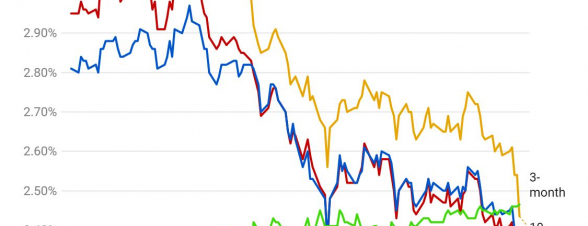So, the Yield Curve Inverted. Is the Sky Falling? We say, “No.”
Late last week news headlines informed us that the yield curve has inverted which may signal a coming recession. What does this mean? Is it another alarmist news story, or should investors be concerned? While this subject will be treated more in depth in our upcoming Quarterly Market Commentary, we wanted you to know that we noticed, we are not alarmed, nor do we think you should be.
First, it is important to understand the definition of yield curve. The yield curve is the line created by plotting out yields, usually US Treasury securities, from three months to thirty years. Generally, the line slopes upward from left to right as the maturities increase because investors expect to get paid higher rates when they tie up their money for longer periods of time. As an example, one might reasonably expect to receive a higher interest rate for a ten-year US Treasury note than a Treasury of one year’s maturity. When the yield curve inverts, the slope of the line falls left to right as shorter maturity bonds pay higher yields than longer ones. Last Friday, March 22, 2019, the three-month Treasury paid 2.46% and the 10-year Treasury paid 2.44%. The previous day, the ten-year Treasury Note had paid 2.54%. Thus, the yield curve moved from a rather flattish shape to a slightly inverted shape.
So, what is the hullabaloo all about? Inverted yield curves are counter-intuitive, and some sources say they signal a lack of confidence in the economy therefore signaling a recession. It is true that most recent domestic recessions have been preceded by yield curve inversions, but those inversions preceded recessions by wide ranging periods from seven months to almost two years. Also, there have been two instances, in 1966 and 1998, when an inverted yield curve was not followed by a recession. So while the inverted yield curve is definitely not the norm, it is not cause for undue excitement. Finally, the usual other recession signals are not sounding. The economy is not overheated; we are not experiencing rising unemployment; and interest rates have hardly spiked.
The sky is not falling. The yield inversion tells us what we already know. We will have a recession at some point as part of a normal economic cycle. What this inversion does not tell us is whether this time it is a reliable indicator or a false positive as in 1966 and 1998, nor does it tell us with any precision when a recession will happen, or how mild or severe it will be. When we do experience a recession, which is inevitable, it is best to be reasonably prepared with adequate cash for basic living expenses and short-term capital outlays as we have been counseling clients to do for some time. Reasonable preparation does not include false hopes of timing the market which almost always leads to painful opportunity cost. We are not alarmed, and we hope you will not be either. Call us if you have any questions or would like to discuss this or any other topic. We are here for you!

